Shuangqiao Valley (双桥沟, Double-Bridge Valley), situated in the jurisdiction of Xiao Jin County in Sichuan Province, spans over 30 kilometers with an area of 216.6 square kilometers. To facilitate local transportation, residents constructed two wooden bridges within the valley. One bridge, known as Yangliu Bridge, is crafted from willow wood, while the other, called Pian Bridge, is constructed from fir wood. It is this dual-bridge structure that gives the valley its name.
The terrain within Shuangqiao Valley is steep and winding, featuring a diverse landscape of snow-capped peaks, pastures, meadows, and forests. The scenery includes extensive birch and poplar forests commonly found in the low mountain zones, as well as high-altitude forests of spruce, fir, and redwood, interspersed with thickets of seabuckthorn, shrubs, and deciduous pines. During the spring and autumn seasons, the valley transforms into a spectacular display of vibrant colors. Visitors can easily explore the valley and enjoy its wonders by taking sightseeing cars that travel directly to the end of the gorge.
Table of Contents
- Basic Information
- Location and Transportation
- Highlights of Shuangqiao Valley
- Map and Recommended Route
- Vlog about Shuangqiao Valley
- Useful Tips from Genuine Reviews
- Attractions near Shuangqiao Valley
Basic Information
| Estimated Length of Tour | 5 hours |
| Ticket Price | 80 RMB (1st April – 30th November) 50 RMB (1st December – 31st March the next year) |
| Shuttle Bus | 70 RMB |
| Opening hours | 7.30 – 16.00 (1st April – 30th November) 8.00 – 15.30 (1st December – 31st March the next year) |
| Telephone Number | 0837-2791063 |
Location and Transportation
Shuangqiao Valley is located in the southwestern part of China, specifically in Aba Autonomous Prefecture, Sichuan Province. It lies in the Min Mountains, which are part of the larger Hengduan Mountain Range. The valley is situated near the city of Ya’an, approximately 150 kilometers (93 miles) southwest of Chengdu, the capital of Sichuan Province.
Apart from driving yourselves, visitors to the valley can take coaches to Xiaojin (小金) at Chadianzi Bus Station (茶店子车站) in Chengdu and tell the driver that you are going to get off at Shuangqiao Valley. The coach departs at 10.00 every morning and costs 95 RMB.
Highlights of Shuangqiao Valley
Bonsai Shoal

Baosai Shoal stretches approximately 1.5 kilometers in length and spans several dozen meters in width, consisting of two large sections with a pearl bank nestled in between. Thousands of ancient seabuckthorn trees adorn the shoal, showcasing their towering and robust forms. The branches of these tall and large seabuckthorn trees twist and extend, displaying both the ruggedness of ancient pines and the elegance of garden bonsai, maintaining a majestic and upright stature.
The formation of Baosai Shoal is attributed to the accumulation of sediment carried by mountain floods, leading to the diversion of the river and the submersion of seabuckthorn trees that originally grew on dry land. The stream water, rich in calcium, was avidly absorbed by the seabuckthorn trees before they succumbed to submersion. This absorption led to the accumulation of substantial amounts of calcium in their roots, allowing these seabuckthorn trees to remain standing even in death.
Five-Color Mountain

The Five-Color Mountain stands out as one of the most distinctive peaks within the Shuangqiao Valley, situated approximately 8 kilometers from the valley entrance at an elevation of 4800 meters. When viewed from a distance, it resembles a semi-circle of just-risen dark crescent moon, with ice and snow adorning its surface, creating a shimmering effect akin to a celestial glow. Upon closer inspection, the massive mountain is embedded with a colossal semi-circular rock formation, about 1 kilometer in length, showcasing five distinct colors – red, yellow, green, blue, and white. The arrangement of colors is remarkably orderly. It is said that in summer, as the white snow melts, the exposed rocks reflect sunlight, casting a faint halo that resembles a beautiful rainbow suspended against the azure sky.
Pearl Shoal

The Pearl Shoal is a breathtaking highlight of the Shuangqiao Valley scenery. Every spring, as the melting snow descends from the mountains, it meanders through the forests and flows across grassy slopes. When it encounters a chaotic slope of several dozen meters in width, it transforms into a playful child navigating through an ordinary landscape before suddenly encountering a rugged mountain path. Here, the water dances and frolics among the scattered stones, creating a whimsical display. When sunlight graces the scene, it illuminates the water droplets like glistening pearls, creating a radiant and enchanting spectacle on the rocks.
Map and Recommended Route

When visiting Shuangqiao Valley, you can take a sightseeing bus that will take you all the way to the mountain’s peak, allowing you to explore and capture stunning photos on your way down. Here’s a detailed route:
- Redwood Forest (红杉林) (Elevation: 3,840 m): The bus will take you to the highest point where you can find the Redwood Forest. From there, you can explore the area station by station. You’ll find snack shops and oxygen supply stations, and the scenery is breathtaking.
- Potala Peak (布达拉峰) (Elevation: 5,240 m): Nearby, you’ll see prayer flags and a white stupa, along with a popular scenic road. This area is perfect for photography, so feel free to snap away!
- Sigu Nacuo Lake (四姑娜措) (Elevation: 3,588 m): Don’t miss this beautiful spot, which features a picturesque combination of half lake and half dry trees, making for stunning views.
- Nianyu Dam (撵鱼坝) (Elevation: 3,500 m): In the summer, you can enjoy a magical drifting experience at the foot of the snowy mountains for 90 yuan per person.
- Longzhu Cuo Lake (隆珠措) (Elevation: 3,490 m): This lake is similar to Sigu Nacuo, featuring dry, fallen trees and tranquil waters, providing another serene spot to enjoy.
- Ginseng Fruit Flat (人参果坪) (Elevation: 3,300 m) [Final Stop]: This area encompasses hundreds of acres of meadows where yaks graze leisurely, adding to the picturesque landscape.
Vlog about Shuangqiao Valley
Useful Tips from Genuine Reviews
Transportation and Route: Buses from the park entrance directly transport visitors to the top of the mountain where the Redwood Forest is. The park bus then descends for sightseeing. This route is suitable for those with average physical fitness but be cautious as the mountain roads can induce altitude sickness and motion sickness.
Oxygen Cylinder and Altitude Sickness: Oxygen cylinders are highly recommended! Altitude sickness can significantly dampen your enthusiasm for exploration. If feeling unwell, promptly use oxygen to alleviate symptoms.
Local Produce and Food: Beware of black pears sold as “high-mountain snow pears.” Locals claim these are wholesale goods from other provinces. However, eating a crunchy, sweet, slightly acidic pear can be soothing amid altitude discomfort.
Food Options at Different Stops: Each scenic spot offers local food like corn, ribs, sausages, and potatoes. At the Buddha Peak spot, there’s the Niu Pengzi Coffee Shop offering butter tea, hand-grabbed lamb, and barley cakes.
Clothing Considerations: Bring a thick jacket; evenings can be very cold. Layer with a short-sleeved shirt or tank top underneath for sunny periods, as it can get hot when the sun is out.
Climate and Sun Protection: The climate in western Sichuan is dry, and the UV rays are strong. Prepare sunglasses, moisturizer, sunscreen, and even an umbrella for sun protection.







